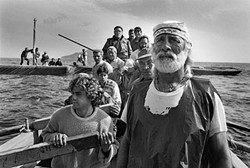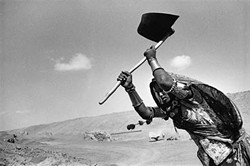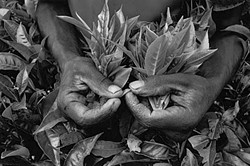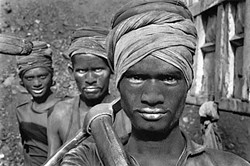Photographer Sebastião Salgado bears witness to the world in black and white
By Andrew Long, Fri., Dec. 19, 2008

Fishing crews assemble early in the morning, ready to leave for the Mattanza, Sicily, Italy, 1991
Photo by Sebastião Salgado
Originally trained as an economist, Salgado first began taking photographs in 1970 with a camera borrowed from his wife during an economic advisory trip across Africa. He viewed this as a chance encounter with photography. Three years later, he quit his profession and returned to Africa to document the increasing famine travesty there. For the next decade, he worked for various international magazines as a photojournalist. Wanting to tell a story with greater complexity than an immediate editorial deadline would allow, Salgado again abandoned what he knew and devoted himself primarily to project-based documentary work. Today Salgado is regarded as an activist and a documentary photography superstar, although he sees himself differently. He believes that without fate, he would still be back home in Brazil, working on his family's farm. "I don't feel I am an activist; it is a way of life." Salgado, the songbird, recognizes that the abilities to witness and to act are within everyone. His images allow viewers to confront their own feelings about a subject because he explores it with such a gripping intensity and thoroughness.
In addition to becoming a master and champion of documentary photography, Salgado pushed the boundaries of the form by creating aesthetically heightened images. Given the subject matter, his photographs are often perceived as being too beautiful. He has also enlarged the scope and length of the traditional documentary project to epic proportions by exploring and documenting a subject over several years.
Salgado not only crossed over into the art world but broke new ground in the ways in which projects were funded and images were presented by partnering with nongovernmental organizations such as Doctors Without Borders and UNICEF.
Photography as the agent of social or political change is largely a 20th century practice but has its roots in efforts such as the Glasgow Improvement Trust's commission of Thomas Annan to document the Scottish working-class slums in 1868 and Jacob Riis' series "How the Other Half Lives" 22 years later. Riis' images of New York City's immigrant poor moved then-head of the New York City Police board of commissioners and future President Theodore Roosevelt to initiate reformation of police-run poorhouses, perhaps the first time photography provoked a call to action.
As the Industrial Revolution provided new opportunities for exploitation, Lewis Hine's images of children toiling in sweatshops helped prompt Washington to draft sweeping child-labor laws.With a specific image in hand for all to see, no one could deny the truth.
Walker Evans, Dorothea Lange, and former University of Texas professor Russell Lee were all part of America's largest governmental effort to record history when the Farm Security Administration hired noted photographers to document the effects of the Great Depression. Lange's image Migrant Mother is perhaps the most recognizable and defining image of this era. Today, Iris Davis, a resident of Austin, is the official printer for the Dorothea Lange Collection at the Oakland Museum and is often asked to make trips to California just to print this iconic image.
Austin currently has several high-caliber documentary photographers, including Donna De Cesare and Eli Reed of the UT Documentary Center and the Texas Center for Documentary Photography's Alan Pogue. Collectively, they have been on the front line documenting war, famine, refugees, racism, prison, and migrant farmworkers abuse. (Austin is also home to award-winning documentary filmmakers Paul Stekler and Hector Galán, whose work has been shown on PBS.)
The difference between a photojournalist and a documentary photographer is often confused. De Cesare defines it like this: "A photojournalist covers a crisis in Act I. The documentary photographer might also cover that but goes on to explore Act II and further – the aftermath, the what, the why." Pogue says: "As a photojournalist, your time is so limited. Normally, you have a couple of days or a week to cover an assignment. Magazines are only going to print three to four images, so you automatically self-edit as you go. By working on a project over a longer period of time, you can record all the seasons, all the parts, all the players in order to get to the truth."
Images reflect who we are in real time. The overused phrase "the camera does not lie" is repeated in mythic proportions. The stark images of Abu Ghraib make a solid case for such a statement. All moments are historical, although some events have greater significance than others. It is the job of the documentary photographer to parse this difference. When the camera's shutter fires at 1/500, it is recording a precise moment by opening and closing to let light in at one-five-hundredth of a second. It is unfathomable just how fast this is. The great French photographer Henri Cartier-Bresson coined it the "decisive moment."
Today, the moving image has vastly replaced the fixed image. During the golden age of photojournalism after World War II, photographs ruled. Images such as the six soldiers raising the flag on Iwo Jima or Jack Ruby shooting Lee Harvey Oswald are seared in our memories, leaving us to fill in with our own imaginations what happened before and after those decisive moments. With the World Trade Center attacks in 2001, nothing was left to the imagination. One could not escape the graphic moving images of the planes crashing into the twin towers as documented by numerous personal and professional sources, shot from multiple angles, and replayed countless times. Our memories of this tragic event are remembered through several seconds of footage. The once powerful decisive moment was elongated and virtually eclipsed.
Salgado's work is so rewarding because we are able to navigate simultaneously his emotionally precise images and the body of work as a whole. The first allows us to stop and contemplate each moment. The second overwhelms us, moving us in time and providing an overarching theme and its humanitarian ramifications. "I want to provoke a discussion, to provoke a debate," Salgado has said. He is our truth seeker.
But truth can be a slippery concept, as history has proven. News publisher William Randolph Hearst fabricated events during the Spanish-American War, leading to the term "yellow journalism." Fast forward to Fox News' coverage of weapons of mass destruction during the buildup to the Iraq war. Some things don't change. "You have the responsibility to bear witness and to record truthfully. You are the front line of history, making a record that others in 50 years will go back to for context," De Cesare says.
How the photographer chooses to document an event can influence our perception of it, though. Use of a long focal-length lens will compress the space, seeming to bring parts of the image closer together. (Look at images of a football game in the newspaper, and players seem piled up on one another, even though in reality they are yards apart.) A wide-angle lens increases the subject's intensity, broadening the picture plane by pushing the background away and pulling the foreground close. The latter is a technique Salgado often uses to his advantage; he makes the subject larger than life, adding an emotional intensity and creating a comparative composition.
Where Cartier-Bresson photographed from an almost voyeuristic distance, placing the viewer on the outside, Salgado moves the viewer inside. His compositions are charged with concave lines, forced perspectives, and often employ triangular structures where your eye is determined to shift.
Although Salgado is rooted in documentary photography, the formal and visually charged images he creates generate discussions usually reserved for art world photographers. He activates the picture frame in such a way that one can't help but look. And isn't that the point? Look at these starving children; look at these exploited workers; look at this injustice. More importantly, the viewer becomes an active participant, which leads to awareness, which, in turn, hopefully leads to change.
"Salgado has his photography foot in several circles, the art print world as well as photojournalism and documentary," says Pogue. "Russell Lee would show every aspect and let the body of work explain it. It wasn't based on an individual image. Salgado does both; each image is riveting, as well as the whole."
Salgado's prints are extraordinary. Normally, photographers strive to create a tonal range, to have just a bit of black on one end of the spectrum and a tad of white on the opposite, with a myriad of rich gray midtones in between – the equivalent to a composer's use of half, quarter, eighth, and sixteenth notes. In most cases, Salgado does the opposite, restricting the dynamic range of the print. He pushes the shadowy areas to be void of light, almost punk. By limiting the viewpoint, he creates a less-is-more event and therefore makes you look deeper. The prints almost seem to be illuminated from the inside, an effect accomplished through selective bleaching and edge burn, a technique in which the perimeter of the frame is printed slightly darker so your eye is forced to the middle.
"The print size is so manageable, especially in this age of large digital prints. They invite you to walk up and view them in a more personal way," Davis says. "The quality of the black-and-white prints is extraordinary. The people in Salgado's photographs are living under the most horrible conditions and circumstances. By making a beautiful image, he is honoring them the best way he can, just as Lange did with Migrant Mother."
The decision by Salgado to exhibit and sell his work through art galleries and museums has been controversial, as some view this as the commodification of others' suffering. "Salgado is one of the first documentary photographers to position himself in the art world," says De Cesare. "He made it possible for large groups of people who don't have the interest or inclination to be socially or politically challenged. He made it easier for them to look because the prints are so stunningly beautiful, which is something he has also been criticized for."
Salgado is determined to enlist us all in witnessing our humanity. He bridges the geographic distance between people here and in other lands, between us and them, eventually dismantling such distinctions. "My hope is that, as individuals, as groups, as societies, we can pause and reflect the human condition. In its rawest form, individualism remains a prescription for catastrophe." Salgado the truth seeker wants us all to bear witness. His images continually remind us that the decisive moment for change is now.
"Workers: Sebastião Salgado" is on view through Feb. 8 at the Austin Museum of Art – Downtown, 823 Congress. For more information, call 495-9224 or visit www.amoa.org.
Alan Pogue
Alan Pogue's Vietnam experience as medic and chaplain's assistant transformed his life and still impacts his point of view to this day. "We were over there under the guise of democracy and combating communism, according to the government. Meanwhile, we were wreaking havoc and compromising their humanity. After I witnessed such deception firsthand, I am doubtful what we read in the newspaper is truthful. Today, there is no end to the gratuitous suffering being caused by governments worldwide, and we need to show the real truth." – A.L.www.documentaryphotographs.com
Donna De Cesare
Award-winning documentary photographer Donna De Cesare's groundbreaking coverage of Los Angeles gangs to Central America and paramilitary violence in Colombia has brought her much acclaim. "I have a responsibility to the subject or, as I prefer, protagonist to transcend the moment itself and tell the whole story," she says. "Salgado can accomplish this so poetically and lyrically. The images of Brazilian gold-mine workers are very powerful. This is what it must have looked like when the Egyptians were building the pyramids. These photographs transport us back in time." – A.L.www.donnadecesare.com
John Langmore
Like Salgado, local photographer John Langmore started off in the world of public policy. Last year, whenever he was not consulting across Texas about transportation and land usage, Langmore was documenting the dramatic effects of community displacement in East Austin. He recently exhibited this photographic body of work at the Mexican American Cultural Center and Huston-Tillotson University. Langmore is currently developing "Fault Line: A Portrait of East Austin" into a book. Mary Ellen Mark, another internationally recognized documentary photographer, has offered to write the book's introduction, which testifies to the strength of his work. It was Langmore who first pitched the Salgado exhibition idea to Austin Museum of Art. "For years I have worked on many social justice causes and supported the Texas Civil Rights Project. Converging two things I feel passionate about has been rewarding. Salgado's ability to tell the story of truth is second to none." – A.L.www.johnlangmorephotos.com
Instituto Terra
Over the years, Sebastião Salgado has directly supported multiple humanitarian causes – including extreme malnutrition and polio eradication – by donating money, photographs, and personal resources. With an increased awareness of the environment's importance to human life, Salgado and his wife, Lélia, created the nonprofit Instituto Terra in 1998. It has planted more than 1.1 million trees in addition to creating an educational agriculture center focused on sustainability. Instituto Terra is the largest environmental recovery program of the Atlantic rainforest in Brazil. – A.L.www.institutoterra.us
READMORE
KEYWORDS FOR THIS STORY
Sebastião Salgado, documentary photography, Austin Museum of Art, Alan Pogue, Donna De Cesare, Iris Davis, Texas Center for Documentary Photography, UT Documentary Center
More documentary photography
More Arts
More by Andrew Long
ARTS ARCHIVES »
TODAY’S EVENTS
Graveyard, the Shrine at Emo's East
UT Energy Forum
at Texas Union

High Noon at Belo Center for New Media Auditorium
MORE RECOMMENDED EVENTS »
MUSIC | FILM | ARTS | COMMUNITY
THELATEST
What About 'The Man Who Shot Liberty Valance'? Regarding Glenn Frankel's book and your 1993 review of The Searchers, my two cents: The Searchers, while arguably John Ford's ...
SXSW Music List in Excel This is the second time in two years that I've asked for a list of the South by Southwest bands ...
Environment Should Be Everyone's Concern I enjoyed reading "Bill of the Week: Changing the Climate" last week and have been thinking about the controversy behind ...
Better Advocate on the Outside Than the Inside Re: “A Failure to Communicate”: While I appreciate Richard Whittaker’s perspective on the Austin Independent School District and the Department ...
'Infowars' Is Extremist Literature I've noticed that stacks of free copies of Alex Jones' fearmongering rag Infowars have popped up everywhere around town from ...
MORE LETTERS TO THE EDITOR »
- Follow us at twitter.com/AustinChronicle
- Rene Ortiz's @SwayThai serves up Thai cuisine with a twist http://t.co/yKQHVlWpmf
twitter.com/AustinChronicle - RT @chronic_jordan: Speed Bump on the Rocket Docket: False-positive field tests derail #drug prosecutions http://t.co/XXVFWtMgR1
twitter.com/AustinChronicle - This week's cover story: 'Only the Young' charts the agony and ecstasy of a certain age @OTYfilm http://t.co/EKvZlso2bd
twitter.com/AustinChronicle - Tickets for the @MusicAwardsSXSW are on sale now at @waterloorecords and online at @Ticketbud #SXSW http://t.co/Lnxge6XxZW
twitter.com/AustinChronicle




No comments:
Post a Comment